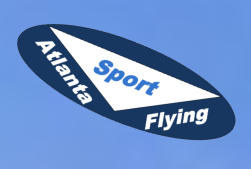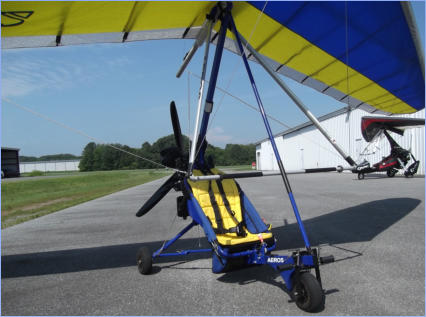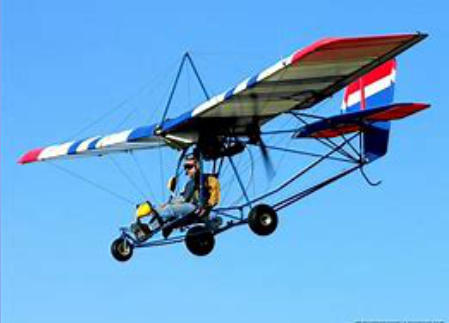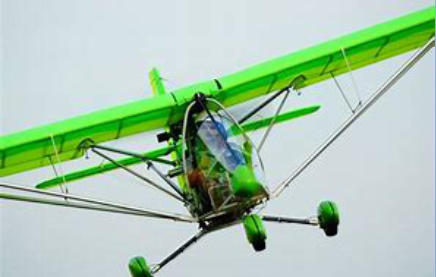




FAA Part 103 single place Ultralights do not require
a Sport Pilot License
It is possible to fly an aircraft without a pilot license under FAA FAR Part 103 if
the aircraft meets the following requirements.
Is single seat
Weights less than 254 pounds empty weight
Has a fuel capacity not exceeding 5 U.S. gallons
Is not capable of more than 55 knots ( 63.4mph) calibrated airspeed at
full power in level flight
Has a power-off stall speed which does not exceed 24 knots (28mph)
calibrated air speed.
No license should not be
confused with ‘no skill
required to fly’. Flying a
Part 103 Ultralight
requires similar piloting
skills to the slower flying LSA’s and proper training should be obtained, but
FAA written and practical tests will not be required and your instructor will
decide when you are ready to fly your Ultralight - training time should be less
than the 20 hour LSA minimum. Despite being no license the Ultralight Pilot
must understand and obey the FAA FARs with respect to the local airspace,
airport patterns, cloud clearance rules etc. - a sectional and airport facility
directory for the local area is a must.
Ultralight training will need to take place in an LSA so the training hours will
count to the Sport Pilot 15 hour dual training requirement a big advantage if
the student later decides to obtain the Sport Pilot certificate. The experience
gained during the solo Ultralight hours will also make the Sport Pilot practical
test much easier to take.
Aircraft flying under the Part 103 rules do not need to be registered with the
FAA, do not require an ‘N’ number and do not require an annual airworthiness
inspection by an FAA certified A&P which reduces operating cost. Part 103
Ultralights by definition are simple aircraft and easily maintained by the
owner.
Due to the greater required structure it is hard to build a conventional
controlled aircraft to the Part 103 weight limit and provide a engine with
reasonable power – hence the pre-LSA emergence of ‘fat ultralights’ which
looked like a Part 103 machine but due to Rotax 447 or 503 engines were
overweight and although widely flown, illegal – for a long period the FAA
‘looked the other way’ but those days are gone – fat ‘ultralights’ are now
classified as LSAs.
A single seat trike can easily meet the Part 103 requirements, even when
powered with a Rotax 447 or similar engine and with the correct wing a trike
will easily cruise in the 50 to 60 mph range and climb at 1000ft per minute -
the Rotax 447 is fuel efficient and will give over 2.5 hours flying time on 5 gallons of fuel so reasonable cross country flying is
possible. If soaring/gliding is more to your liking then trikes with a lighter loaded wing and smaller engine make great soaring
machines – and more convenient than hill or tow launched hang gliders.
A single seat trike is a little easier to fly than a two seat trike due to the lower stall and landing speed so the training time should be
well less than the 20 hr Sport Pilot minimum. When transitioning from a two seat to single seat trike other than the slower landing
speeds the biggest difference will be the much lighter and in my opinion more pleasant handling – before you solo your single seat
trike your instructor will brief you on the differences. A single trike seat trike when flown in reasonable weather is a very safe
aircraft and can be landed power off in a very small space – great fun to fly.
A single seat trike provides a great way to start flying for a small investment, maintenance is minimal, easy to transport and rig, can
be kept in a garage - no hangar required, and the training hours will count towards your Sport Pilot if your wish to transition to a
LSA. A well looked after single seat trike has good re-sale value.


















